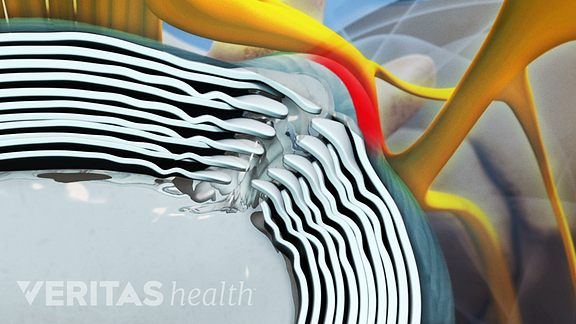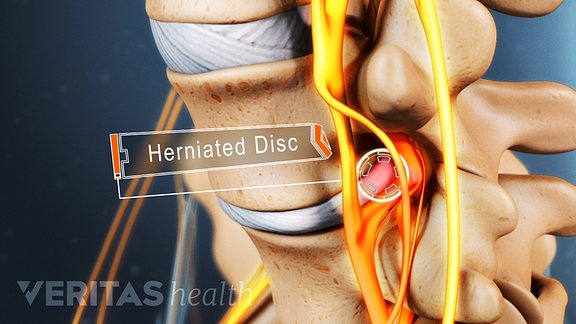As a disc degenerates, the soft inner gel in the disc can leak back into the spinal canal. This is known as disc herniation, or herniated disc. Once inside the spinal canal, the herniated disc material then puts pressure on the nerve, causing pain to radiate down the nerve leading to sciatica or leg pain (from a lumbar herniated disc) or arm pain (from a cervical herniated disc).
What’s a Herniated Disc, Pinched Nerve, Bulging Disc…?
Many terms may be used to describe issues with a spinal disc and disc pain, and all may be used differently and, at times, interchangeably. Some commonly used terms include:
- Herniated disc
- Pinched nerve
- Ruptured/torn disc
- Bulging disc
- Disc protrusion
- Slipped disc

A herniated disc occurs when inflammatory proteins from a disc’s inner core leak out.
There is no main consensus on the use of these terms, and it can be frustrating to hear one diagnosis described in many different ways.advertisement
The medical diagnosis identifies the underlying cause of back pain, leg pain, and other symptoms. It is more useful to gain a clear understanding of the medical diagnosis than to sort through various medical terms.
Two Causes of Pain: Pinched Nerve vs. Disc Pain
There are two main ways a spinal disc can cause pain:
- Pinched nerve. In most cases a herniated disc itself is not painful, but rather the material leaking out of the disc pinches, inflames, or irritates a nearby nerve, causing radicular pain. Radicular pain (also called nerve root pain), describes sharp, shooting pains that radiate to other parts of the body, such as from the low back down the leg or from the neck down the arm. Leg pain from a pinched nerve is commonly called sciatica.
- Disc pain. A spinal disc itself may be the source of pain if it dehydrates or degenerates to the point of causing pain and instability in the spinal segment (called degenerative disc disease). Degenerative disc pain tends to include a chronic, low-level pain around the disc and occasional episodes of more severe pain.
A herniated disc and degenerative disc disease typically occur in the cervical spine (neck) and lumbar spine (lower back). Disc pain tends to be most common in the lower back, where most of the movement and weight-bearing in the spine occurs. These conditions are uncommon in the mid-back (the thoracic spine).
About Sciatica
Sciatica is a term used to describe nerve pain in the leg that is caused by irritation and/or compression of the sciatic nerve. Sciatica originates in the lower back, radiates deep into the buttock, and travels down the leg.

Sciatica is nerve pain that originates in the lower back and radiates down the buttock to the thigh and leg on one side. The pain may be accompanied by numbness and/or weakness.
What Does Sciatica Feel Like?
The symptoms of sciatica are commonly felt along the path of the large sciatic nerve. Sciatica is often characterized by one or more of the following features:
- Pain. Sciatica pain is typically felt like a constant burning sensation or a shooting pain starting in the lower back or buttock and radiating down the front or back of the thigh and leg and/or feet.
- Numbness. Sciatica pain may be accompanied by numbness in the back of the leg. Sometimes, tingling and/or weakness may also be present.
- One-sided symptoms. Sciatica typically affects one leg. The condition often results in a feeling of heaviness in the affected leg.1 Rarely, both legs may be affected together.
- Posture induced symptoms. Sciatica symptoms may feel worse while sitting, trying to stand up, bending the spine forward, twisting the spine, lying down, and/or while coughing. The symptoms may be relieved by walking or applying a heat pack over the rear pelvic region.
It is important to note that any type of lower back pain or radiating leg pain is not sciatica. Sciatica is specific to pain that originates from the sciatic nerve.1
Causes of Sciatica
Sciatica is the symptom of an underlying medical condition.2Understanding the possible causes of sciatica can help focus treatment on addressing the root problem rather than just masking the symptoms.
The mechanism of sciatic nerve injury is either a result of direct nerve compression, inflammation, an abnormal immune system response of the body, or a combination of all these factors.5,7
Common Causes of Sciatica

A herniated disc in the lumbar spine may affect a sciatic nerve root causing direct compression or chemical inflammation, resulting in sciatica.
Common causes of sciatica include:
- Lumbar herniated disc. Research suggests that up to 90% of sciatica is caused by a lumbar herniated disc.7 The herniated disc typically compresses one or more spinal nerve roots (L4-S3) that form the sciatic nerve. A lumbar herniated disc can cause sciatica in two ways:
- Direct compression. Direct compression of the sciatic nerve can occur when a lumbar disc bulges (contained-disc-disorder) or when the soft inner material of the disc leaks out or herniates through the fibrous outer core (non-contained disc disorder) and presses against the nerve.
- Chemical inflammation. An acidic chemical irritant from the disc material (hyaluronan) may leak out and cause inflammation and irritation in the area around the sciatic nerve.7,12-13A herniated disc may compress the sciatic nerve on one side, causing symptoms in one leg, or the disc may bulge or herniate from both sides, causing symptoms in both legs (bilateral sciatica). Bilateral sciatica may also be caused by two adjacent segments discs herniating on either side, although this possibility is rare.See Lumbar Herniated Disc Symptoms
- Degeneration. Degeneration of tissues in the lumbar spine can compress or irritate the sciatic nerve. Degeneration of the facet joints can also cause the synovial tissue in the joint’s capsule to inflame and increase in bulk. Degeneration of vertebral bone may cause abnormal bone growths (bone spurs or osteophytes). These abnormally bulky tissues in the lumbar spine may cause compression of one or more nerve roots of the sciatic nerve. Degenerated intervertebral discs may secrete inflammatory proteins, causing inflammation of the sciatic nerve.
- Lumbar spinal stenosis. Spinal stenosis is the narrowing of the spinal canal and is relatively common in adults older than age 60.16 Research suggests that lateral recess stenosis may be common in causing sciatica in the elderly population.
- Spondylolisthesis. Spondylolisthesis occurs when a small stress fracture causes one vertebral body to slip forward on another. For example, the L5 vertebra may slip forward over the S1 vertebra. Sciatica may result from nerve compression following the disc space collapse, fracture, and forward slipping of the vertebral body. Spondylolisthesis may cause bilateral sciatica and is more common in younger adults.
These conditions may develop over time or spontaneously due to trauma or physical stress injury. Motor vehicle accidents, sports injuries, or falls may cause direct injury to the sciatic nerve. Conditions such as spondylolisthesis and herniated discs may develop from physical stress injuries, such as from weightlifting.
Causes of Sciatica-Like Symptoms

Most commonly, the sciatic nerve leaves the pelvis through the greater sciatic foramen below the piriformis muscle (left). Sometimes, the nerve may split and a part of it may pass through the piriformis (right).
Some conditions may cause typical sciatica symptoms. A few examples include:
- Piriformis syndrome. Piriformis syndrome is caused by spasms of the piriformis muscle. Sciatica symptoms may occur when the spasmodic muscle irritates or compresses the sciatic nerve at its origin. This condition is more common when the sciatic nerve is split, which is a normal variant near the piriformis muscle, or in normal anatomical variations of the piriformis muscles itself.17Piriformis syndrome is also common in overuse injuries, particularly in runners and athletes.
- Sacroiliac joint dysfunction. Irritation of the sacroiliac joint—located at the bottom of the spine—can also irritate the L5 nerve, which lies on top of the sacroiliac joint, causing sciatica-type pain.
In these cases, there is no true radiculopathy or radiating nerve pain. However, the resulting leg pain typically feels like sciatica.
Risk Factors for Sciatica
The presence of certain risk factors may increase the likelihood of developing sciatica. A few examples include:
- Smoking
- Mental health issues, such as depression
- Tall height in older age groups (50 to 60 years)
- Obesity and excess weight
- Genetic susceptibility
- Vitamin B 12 deficiency
- Physical de-conditioning from a sedentary, inactive lifestyle
- Certain types of occupation (such as truck drivers, carpenters, or machine operators)
- Poor work ergonomics
What Is Piriformis Syndrome?
Piriformis syndrome is a condition in which the piriformis muscle, located in the buttock region, spasms and causes buttock pain. The piriformis muscle can also irritate the nearby sciatic nerve and cause pain, numbness and tingling along the back of the leg and into the foot (similar to sciatic pain).
Causes of Piriformis Syndrome
The exact causes of piriformis syndrome are unknown. Suspected causes include:
- Muscle spasm in the piriformis muscle, either because of irritation in the piriformis muscle itself, or irritation of a nearby structure such as the sacroiliac joint or hip
- Tightening of the muscle, in response to injury or spasm
- Swelling of the piriformis muscle, due to injury or spasm
- Bleeding in the area of the piriformis muscle.
Any one or combination of the above problems can affect the piriformis muscle (causing buttock pain) and may affect the adjacent sciatic nerve (causing pain, tingling, or numbness in the back of the thigh, calf, or foot).
Piriformis Syndrome vs. Sciatica
The primary symptom of piriformis syndrome is pain along the sciatic nerve, so it is often thought that piriformis syndrome causes sciatica.
However, piriformis syndrome does not originate at a lumbar nerve root, so it is not technically a radiculopathy or considered sciatica. Instead, with piriformis syndrome, the piriformis muscle causes irritation and sciatic pain further down the sciatic nerve. That said, the term sciatica is often used and understood in reference to pain caused by the piriformis muscle.